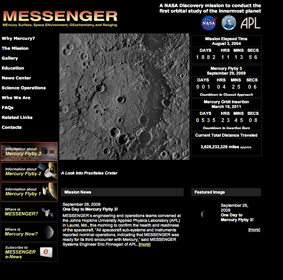About MESSENGER

MESSENGER (MErcury Surface, Space ENvironment, GEochemistry, and Ranging) was a scientific investigation of the planet Mercury, the least explored terrestrial planet, that launched in August 2004, entered Mercury orbit in March 2011, and impacted the surface, as planned, in April 2015.
Understanding Mercury and how it was formed is essential to understanding the other terrestrial planets and their evolution. Prior to MESSENGER, Mercury had been visited by only one other spacecraft, Mariner 10, and we understood little more than its average density (the second greatest of all the planets), the composition of its atmosphere (thinnest of the terrestrial planets), the fact that it posses a global magnetic field, and its extreme variations in temperature. Data from MESSENGER has lifted some of the uncertainty about this innermost planet of our solar system.
The MESSENGER mission entered into orbit around Mercury after making three flybys of the planet, using data collected during the flybys as an initial guide to perform a more focused scientific investigation of this mysterious world. MESSENGER investigated six key scientific questions about Mercury’s characteristics and environment with a set of miniaturized space instruments. The spacecraft entered Mercury orbit in March 2011 and carried out comprehensive measurements for over four-Earth years. MESSENGER received two mission extensions, the first of which began in March, 2012, and the second of which began in March, 2013, ending when the spacecraft impacted Mercury in April 2015.
LASP Instrument
MASCS: Mercury Atmospheric and Surface Composition Spectrometer
LASP developed and built the MASCS instrument onboard MESSENGER. MASCS was designed to detect minerals on Mercury’s surface, and determine the abundance and components of its thin atmosphere. Data from MASCS is helping scientists answer the questions: What is Mercury’s surface made out of? How is Mercury’s atmosphere generated? Does Mercury have ice at its poles?
